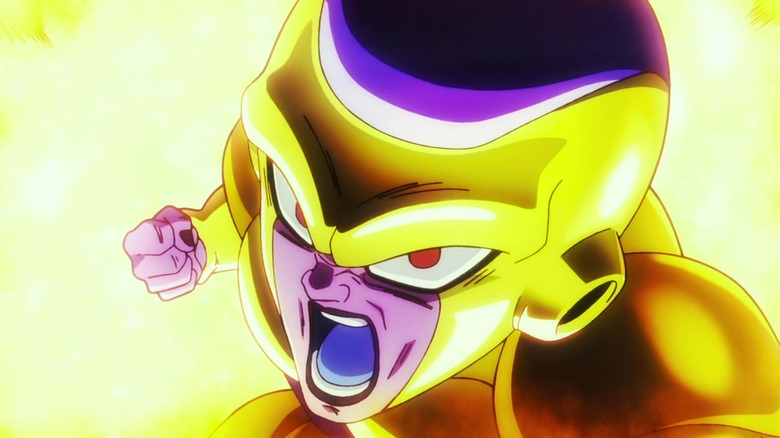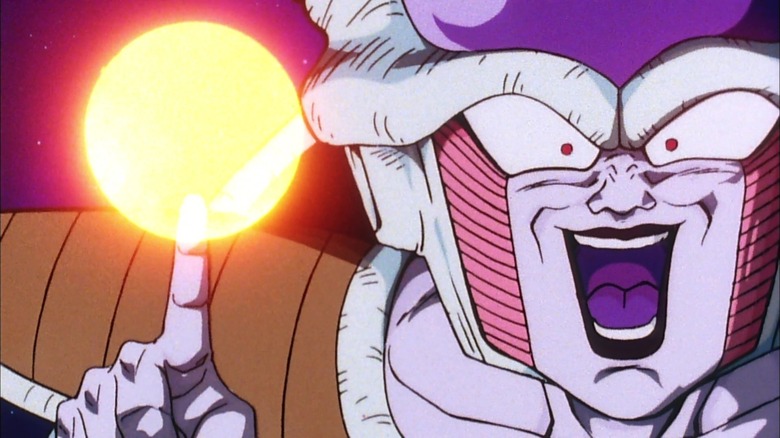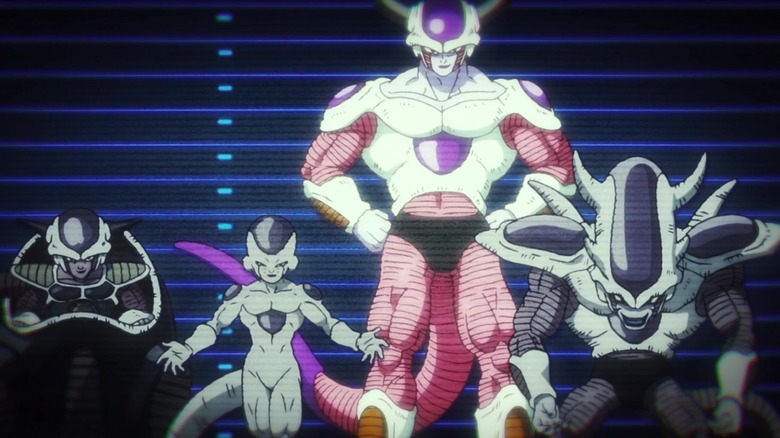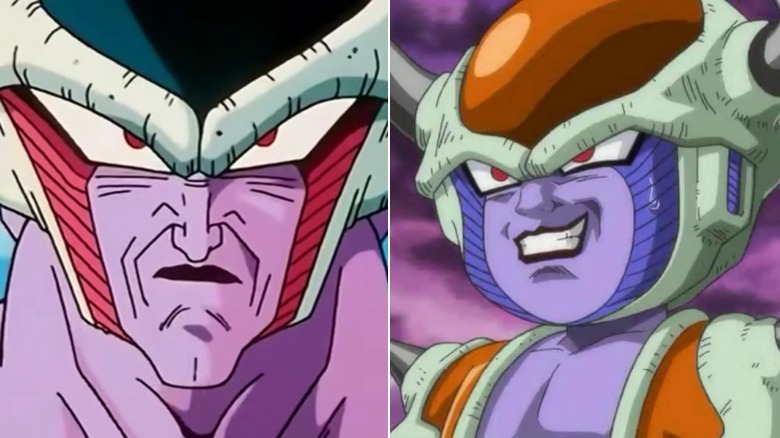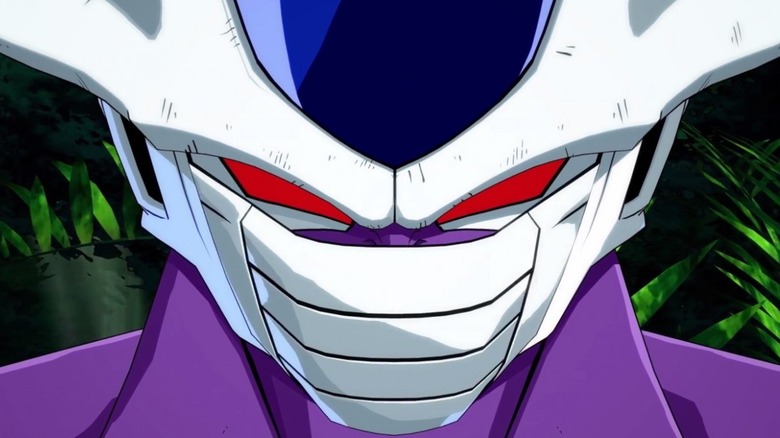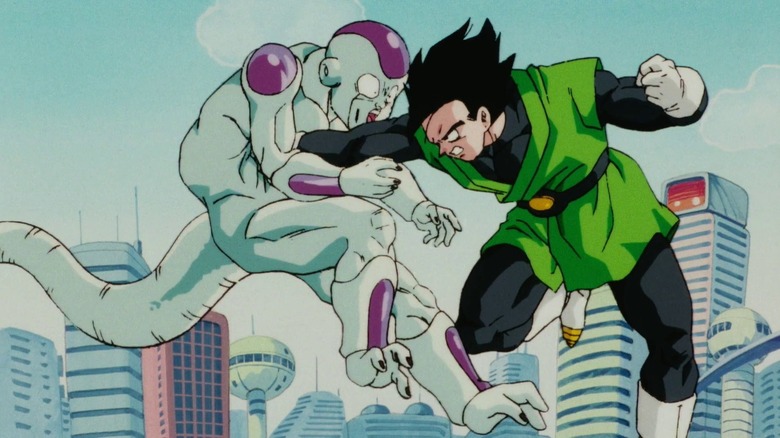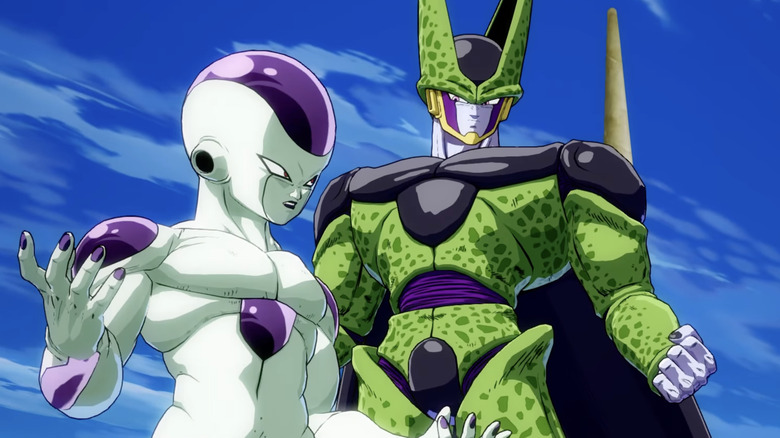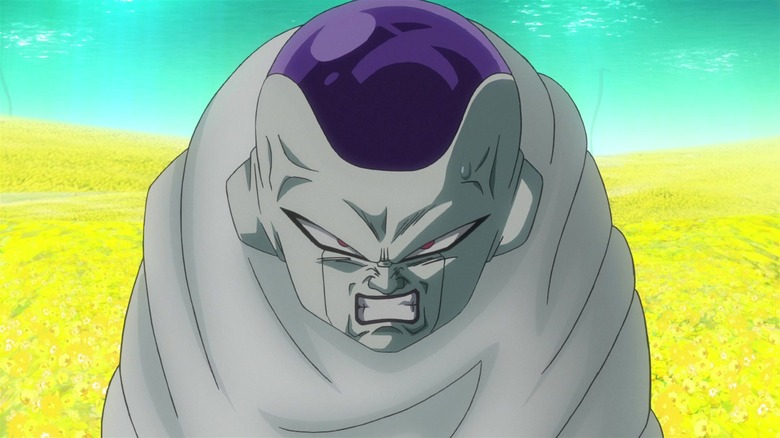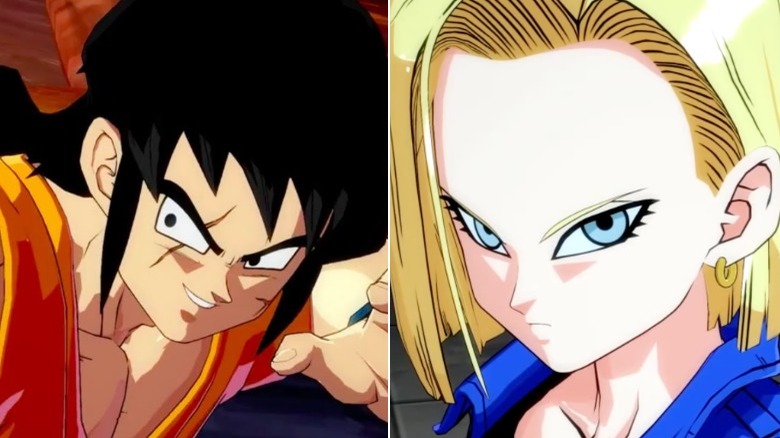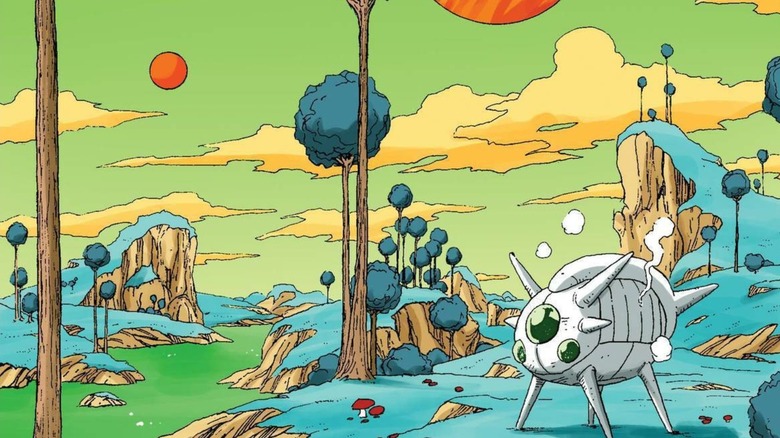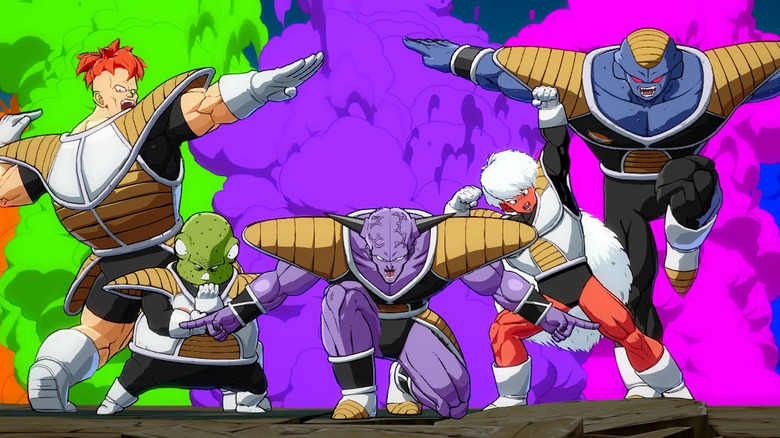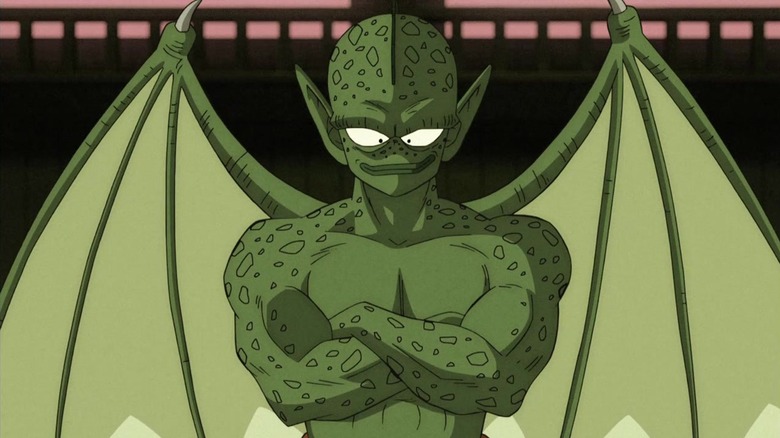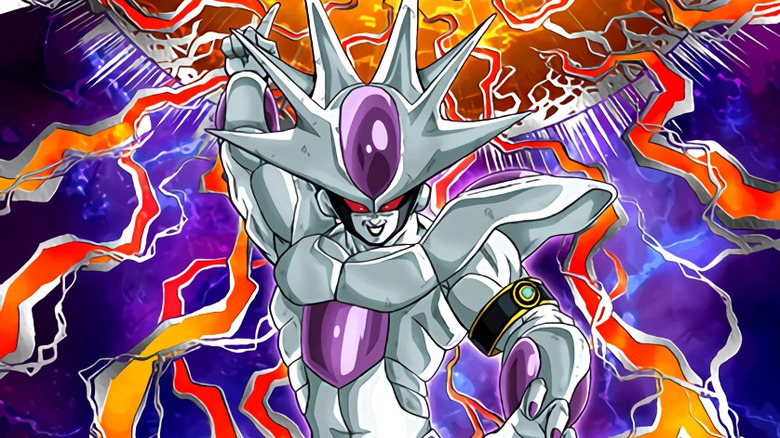Facts About Dragon Ball Z's Frieza That'll Make The Universe Tremble
For all its heroes, the "Dragon Ball" universe is also home to some pretty unsavory customers. Of the latter, few inspire more terror across the cosmos than Frieza. Known for his casual cruelty and thirst for conquest, Frieza first appears in the "Dragon Ball" manga terrorizing the people of Namek in his hunt for the planet's Dragon Balls. Though he is defeated in spectacular fashion by Goku, Frieza has returned time and time again to menace the Saiyan warrior and his friends on the manga page, TV screen, and even a few "Dragon Ball" feature films.
Frieza has recently resurfaced in the "Dragon Ball Super" manga, teasing a whole new level of strength Goku and Vegeta have to worry about. With a rematch between the three fighters inevitably on the horizon, it seems as good a time as any to explore the major and not-so-well-known facts about "Dragon Ball's" self-proclaimed "Emperor of Evil."
He was based on a real phenomenon
Toriyama in general tends to steer clear of any sort of deliberate philosophical or social commentary in his writing, commenting in "Dragon Ball Z Full Color Comics: Freeza Arc Vol. 4" that "As a rule, there is no such thing as a theme in my work."
Frieza, however, seems to be somewhat of an exception. As Toriyama explains in "Dragon Ball Daizenshuu 2: Story Guide," the Emperor of Evil's profession, which involves ridding planets of their population and selling the forcibly vacated property to other species, was inspired by those who sought to take advantage of Japan's massive real estate and economic boom in the late '80s and early '90s in unscrupulous ways. "I came up with Freeza around the time of the Bubble, and the land shark was the worst person of all," Toriyama reveals. "So I made him the #1 land shark in the universe." Sure, Toriyama may not have been trying to make any particular statement in basing Frieza off a real estate con artist, but it certainly can come across that way to readers familiar with the character's origins.
He made transformations commonplace in Dragon Ball
Transformations have always been a part of "Dragon Ball." The first character shown to be capable of transforming is Oolong, but his changes are only cosmetic and don't make him stronger. Conversely, the first character to transform in a way that increases his strength is actually Goku, specifically when he becomes a Great Ape while he and his friends are dealing with the Pilaf Gang.
Yet for the longest time, transformations were really more the exception in "Dragon Ball," rather than the rule. This changes with Frieza, who starts off with a whopping four forms he can change into — most of which have horns. Future villains such as Cell and Majin Buu would also boast multiple transformations, and Frieza himself has discovered two new forms in recent years. The same goes for some of the heroes, particularly Goku and Vegeta, who've each gained more than half-a-dozen transformations since Frieza's debut. Frieza's transformations are so influential, that they've even gained wide Internet popularity, spawning the famed "This Isn't Even My Final Form" meme.
His family tree is bigger than you might think
Of the "Dragon Ball Z" era villains, Frieza has the most expansive family tree seen on-screen. Fans are well aware of his father, King Cold, who hands Frieza control of the Planet Trade Organization in "Dragon Ball Super: Broly" and is killed by Trunks when he and Frieza go to Earth. They also likely know of Cooler, Frieza's older brother from "Dragon Ball Z" Movies 5 and 6, although the two films aren't canon to the main "Dragon Ball" universe.
However, that family tree gets even bigger when one looks at non-canonical material. The special "Dragon Ball: Episode of Bardock," a sequel to "Dragon Ball Z: Bardock — The Father of Goku," introduces Chilled, an ancestor of Frieza who is implied to have first introduced his people to the legend of the Super Saiyan. There is also Kuriza, Frieza's son from Toriyama's famed parody manga "Neko Majin Z," who has the unique distinction of having a name and a cranium inspired by chestnuts. Like Frieza, they're all fairly devious, proving that at least in his family, the apple — or in some cases, the chestnut — doesn't fall far from the tree.
His brother doesn't share his name pun
Even at its most serious, the "Dragon Ball" franchise always retains a very specific element of humor: name puns. Virtually every character's name is a pun — the Saiyans, for instance, have names that come from vegetables, while Piccolo and his family members get their names from instruments. With Frieza, it's no different, as his name is clearly based on the word "freezer."
It'd be an easy assumption, therefore, to assume that Cooler's name is based off, well, a cooler. Astonishingly enough, however, that is not the case. Cooler's name is based off of "kuu ra," which major "Dragon Ball Z" contributors Takao Koyama and Kōzō Morishita explain in "Dragon Ball Z Anime Special II" means "ice-cream manjū" — a vanilla ice cream popsicle with red bean paste for the filling. It's not as big a deviation from the Frieza family pun convention as Kuriza being inspired by the Japanese word for chestnut, but it's definitely a pun that can catch those unfamiliar with Japanese off-guard.
He's only been killed by Saiyans
Frieza has been brought back to life twice — three times, if you count the films — making him the "Dragon Ball" villain with the most resurrections. Which also, of course, means he's the one who's died the most times. His demises have all had something in common, too: they've all been caused by Saiyans, usually of Goku or Vegeta's bloodline.
The first death Frieza experiences is at the hands of the time-traveling version of Vegeta's son, Future Trunks. When the Dragon Balls are used to resurrect Frieza many years later in the movie "Dragon Ball Z: Resurrection 'F'" and its adaptation in "Dragon Ball Super," it's Frieza's arch-foe Goku that blasts the intergalactic land shark into oblivion. Even when Frieza returns in the non-canonical movie "Fusion Reborn," he's killed by a Saiyan, namely Goku's oldest son, Gohan. One can't help but notice that Frieza's fear that Saiyans would one day be strong enough to successfully oppose him was well-founded, even if destroying Planet Vegeta was a pretty extreme attempt to keep that from happening.
His imitators
Frieza is one of the "Dragon Ball" antagonists who has had the biggest impact on the franchise. Aside from being the first foe whose power level extends into the millions, he's also indirectly responsible for the introduction of the Super Saiyan, as his killing of Krillin causes Goku to access the form for the first time. He's also a character of unique contrasts, as his cruelty and raw power are often obfuscated by his formal demeanor and his misleading, less physically-imposing transformations.
So it's no surprise that a villain who's left such an impression would have his copycats. Cell, for instance, carries Frieza's and King Cold's DNA, which allows him the use Frieza's many attacks, including the Frieza Beam (a.k.a. the Death Beam). Furthermore, the original video animation "Plan to Eradicate the Saiyans" and its remake, "Plan to Eradicate the Super Saiyans," features a literal copy of Frieza known as "Ghost Frieza." Delve into the video games and you'll find that in "Dragon Ball Z: Budokai 2," Super Buu is capable of absorbing Frieza into his body, which not only gives him some of Frieza's techniques and physical features, but also his mannerisms and way of speaking.
He's the only Dragon Ball villain canonically seen in the afterlife
"Dragon Ball Z" anime aficionados are likely quite familiar with the series' depiction of Hell, renamed "HFIL" (short for "Home for Infinite Losers") in the Funimation and Ocean Group dubs. Guarded by ogres like Goz and Mez, Hell makes several appearances in "Z" and even in its out-of-continuity sequel "Dragon Ball GT," with Frieza shown in both series as one of the many villains incarcerated there. Interestingly, Frieza and his fellow "Dragon Ball" foes also seemingly keep their bodies, an honor usually reserved by those allowed to train with the four Kais.
None of these scenes are depicted in the original "Dragon Ball" manga, however, bringing their canonicity into dispute. While King Yemma does tell Goku in the manga he has indeed sent Raditz to Hell, it's unclear whether he's done the same to the other villains, leading some fans to believe they've had their souls cleansed of evil and then reincarnated, like Kid Buu.
"Dragon Ball Z: Resurrection 'F'" confirms, however, that Frieza is in a version of Hell, albeit not the one seen in the anime. Specifically, Frieza's stuck in the Hell of the planet he's killed on, Earth, routinely tormented by teddy bear marching bands and other joyous things. Though fans would argue the film technically isn't canon, both the "Dragon Ball Super" anime and manga also depict Frieza in this realm, cementing the canonicity of Frieza's unique punishment.
The major heroes he's never fought
Canonically-speaking, Frieza and his enforcers, known fittingly as the "Frieza Force," have faced nearly every major "Dragon Ball" hero. Even Master Roshi's encountered Frieza face-to-face, though he hasn't fought him directly in physical combat.
That said, three notable heroes have never taken Frieza on, canon-wise. As far as longtime cast members go, there are Yamcha and Chiaotzu, who've basically missed every direct Frieza battle for various reasons. The two have fought members of the Frieza Force in "Dragon Ball Z" filler scenes, sure, namely the Ginyu Force, but that battle's canonicity, not to mention its plausibility, has long been a topic of debate among "Dragon Ball" fans.
A more recent addition to the main "Dragon Ball" cast who hasn't fought Frieza is Android 18. Interestingly, when 18 first appears in "Dragon Ball," she's much stronger than Frieza had ever been up to that point, meaning she would have likely wiped the floor with him had Trunks not killed him three years prior. When Frieza comes back to life and heads to Earth, however, 18 chooses to sit the battle out. While Frieza's become much more powerful by then, 18's presence still would have been a welcome one, especially since she notes she's still stronger than Krillin, who does take part. To be fair, 18 doesn't seem too interested in fighting unless money's involved — perhaps Bulma could have offered her some sort of financial incentive for participating?
He's the first major foe the main Dragon Ball cast fought on another planet
Nowadays it doesn't seem all that out of the ordinary for "Dragon Ball's" protagonists to fight a threat on another planet. Yet before Frieza showed up, Goku's only time dealing with someone while off of Earth is when he drops Monster Carrot and his cronies off on the Moon.
When Frieza attacks Namek in search of the Dragon Balls, that all changes. Sure, you could argue that the first planet besides Earth where the "Dragon Ball" gang has to deal with a threat is Fake Namek, but that's only in the "Dragon Ball Z" anime, so it's not necessarily counted by manga purists. Whatever your feelings about Fake Namek's canonicity, one can't deny Frieza's the first major foe the "Dragon Ball" cast fights on another world, as he's in a pretty different threat class than Fake Namek's antagonists, Raiti and Zaacro. Furthermore, it's the encounters with Frieza on Namek that really changes the ball game for "Dragon Ball" in all kinds of ways, locations included, as it opens the door for later adventures on planets like New Namek and Cereal.
The underlings he always goes easy on
Frieza boasts a vast army at his disposal, made up of denizens from many different planets. While the vast majority of his subjects are deeply loyal to him, they clearly obey Frieza out of fear, especially since the price of failure is often torture or death. Even the fighters most frequently seen with Frieza, Zarbon and Dodoria, are terrified of their overlord, who is only slightly more tolerant of their failures than he is of others.
There are five subjects, however, who have quite different interactions with Frieza. They are the Ginyu Force — Frieza's most powerful enforcers — renowned for their efficiency, team spirit, and love of choreographed poses. Though undeniably goofy, Frieza has a lot of patience for their shenanigans, likely due to their enormous success rate in carrying out their boss' bidding. Frieza even seems to have a healthy friendship with the Ginyu Force's leader Captain Ginyu, and is pleasantly surprised when reunited with the captain in the "Dragon Ball Super" anime.
His connection to Tambourine
On the surface, one might argue Tambourine and Frieza have little in common. One is the green, scaly offspring of Evil King Piccolo, who requires wings to stay airborne. The other is a pink-and-white intergalactic tyrant who has more powers and abilities than Tambourine can dream of. They also appear years apart from each other, with Tambourine appearing in "Dragon Ball" while Goku's still a child, whereas Frieza fights an adult Goku in the manga chapters later adapted into "Dragon Ball Z."
Yet scratch a little deeper and you'll find a wealth of commonalities between the characters. They share a voice actor, Ryūsei Nakao, as well as the nefarious distinction of having brutally murdered Goku's best friend, Krillin. They've also died while trying to fight swordsmen — Yajirobe, in Tambourine's case and Future Trunks in Frieza's — only in Tambourine's case, it's Goku who does the fighting and killing, rather than Yajirobe himself. The two characters' debuts also herald a rising of stakes, as Tambourine and his family go on to kill a number of familiar "Dragon Ball" characters, while Frieza wipes out nearly every Namekian, blows up planet Namek, and pushes the "Dragon Ball Z" cast to new, staggering high strength levels.
The sneaky way he can reach Cooler's unique form
As stated earlier, Frieza has no shortage of transformations to choose from. His hornless "fourth" form is actually his natural state, while his three horned forms are what he uses to keep his power and bloodthirsty behavior in check. Then, of course, is Golden Frieza — a hugely powerful form he reaches after training for just a few months. Most recently, he's also unlocked Black Frieza, a transformation he attains after ten days in a Hyperbolic Time Chamber — the equivalent of a decade's worth of training.
The one form he hasn't attained, however, is the masked, carapace-laden transformation Cooler uses in "Dragon Ball Z" Movie 5. It's unlikely Frieza will ever attain this form canonically, as Movie 5 isn't in continuity and his Golden and Black Frieza forms are much stronger. Yet those itching to see what "fifth form Frieza" would look like need only play the video game "Dragon Ball Fusions" and fuse Frieza with Cooler. The resulting fused being, "Coolieza," basically looks just like Frieza would if he had a "fifth form" of his own, minus the mouth guard. Coolieza is also available to play on "Dragon Ball Z: Dokkan Battle," where players have two playing cards of the characters to choose from.
